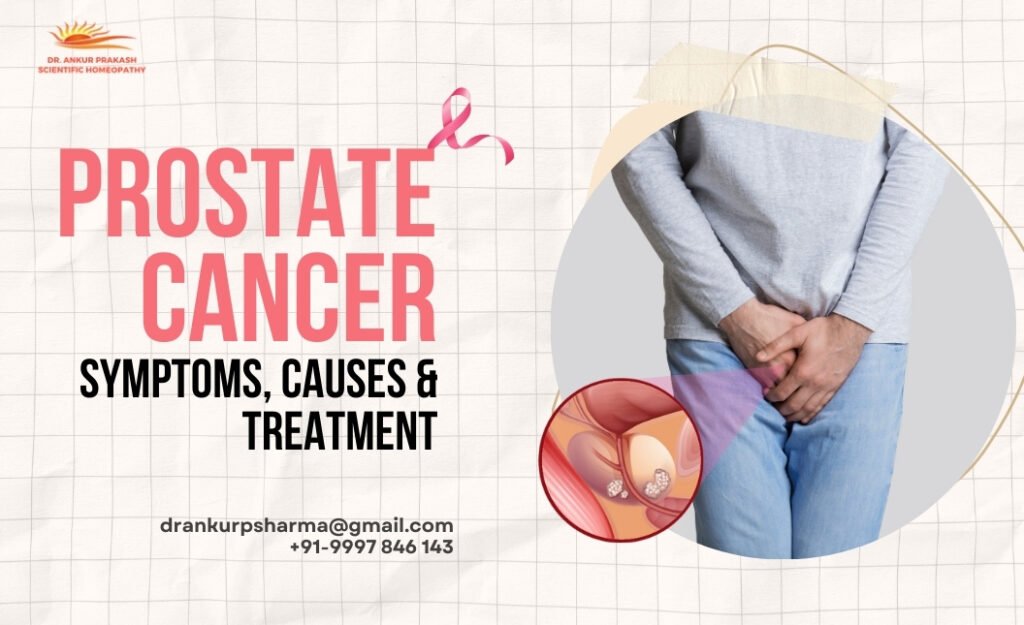What is the Prostate Cancer Problem?
Prostate cancer is a health issue that affects the prostate, a small gland in men that produces fluid for semen. It can develop when cells in the prostate grow abnormally, forming a tumor. Some men may not notice any signs at first, but common symptoms include difficulty urinating, frequent urination, or pain in the lower back. Early detection is key to managing the problem, and Cancer treatment options vary depending on how advanced it is. Regular check-ups and understanding the risks are important for prevention.
Types of Prostate Cancer
Adenocarcinoma: This is the most common type of Prostatic adenocarcinoma, accounting for the majority of cases. It begins in the gland cells that produce the fluid in the prostate, which is part of the semen. Since this form of prostate adenocarcinoma is more frequent, it is generally detected in the early stages and responds well toProstatic adenocarcinoma
treatment.
Small Cell Carcinoma: This type of prostate cancer is quite rare and more aggressive. It grows rapidly and is harder to detect in the early stages because it doesn’t often cause a rise in PSA (prostate-specific antigen). Due to its fast growth, it requires close monitoring and a more immediate Prostatic adenocarcinoma
treatment plan.
Squamous Cell Carcinoma: Another rare form of prostate cancer, squamous cell carcinoma develops in the flat cells of the prostate. This type is typically more aggressive and doesn’t behave like the more common adenocarcinoma, often leading to a faster progression. Early detection can make a significant difference in managing this type of Prostatic adenocarcinoma.
Transitional Cell Carcinoma: This type usually begins in the urethra, the tube that carries urine from the bladder, and can spread to the prostate. If not caught early, it may spread quickly. Like other forms, it requires prompt prostate adenocarcinoma treatment to prevent its spread.
Sarcoma: Extremely rare, sarcoma starts in the soft tissues of the prostate. Due to its rarity, it’s often diagnosed in fewer cases. When detected, it usually requires a specialized approach for prostate adenocarcinoma treatment.
Understanding the different types of prostate adenocarcinoma is crucial for selecting the right Prostatic adenocarcinoma
treatment. Early detection improves the chances of effective treatment, no matter which type is involved.
Symptoms of Prostate Adenocarcinoma
Frequent urination: One of the early signs of prostate cancer is the need to urinate frequently, especially at night. This is often due to an enlarged prostate pressing on the bladder, making it harder to control urination.
Weak urine flow: If you’re finding it difficult to start or stop urinating, or notice a weak flow, this could be related to prostate adenocarcinoma. The tumor can block the urethra, leading to issues with urine flow.
Blood in urine or semen: While not always present, if you see blood in your urine or semen, it’s a serious symptom that should never be ignored. This can be a sign that prostate adenocarcinoma is affecting surrounding tissues.
Discomfort during urination: Experiencing pain or a burning sensation while urinating may signal that the prostate is irritated or inflamed due to prostate adenocarcinoma.
Erectile dysfunction: Prostate cancer can sometimes affect the nerves that control erections, making it difficult to achieve or maintain one.
Pain in the lower back, hips, or thighs: If the cancer has spread, you may experience pain in these areas. This is usually a sign that the cancer has advanced.
Causes
Age: As men get older, their risk of developing prostate cancer increases. Most cases are seen in men over the age of 50. This is why regular check-ups become more important with age.
Family history: If someone in your family, like a father or brother, has had prostate adenocarcinoma, your chances of developing it go up. Knowing your family’s medical history can help with early detection.
Genetics: Some men inherit specific gene mutations that make them more prone to prostate adenocarcinoma. This genetic factor can be a reason for cancer developing even without other risk factors.
Diet: A diet high in processed foods and unhealthy fats, with little fresh fruits and vegetables, can increase your risk of prostate adenocarcinoma. Eating a balanced, healthy diet can help lower this risk.
Hormonal changes: Higher levels of certain hormones, especially testosterone, can cause abnormal cell growth in the prostate, which may lead to cancer over time.
Obesity: Being overweight is linked to a higher chance of aggressive prostate adenocarcinoma. Maintaining a healthy weight through diet and exercise is important.
Smoking: Smoking doesn’t just affect the lungs; it also increases the likelihood of prostate adenocarcinoma spreading and becoming more difficult to treat. Stopping smoking improves overall health.
Homeopathy and Prostate Cancer
Homeopathy provides a natural way to help manage prostate cancer symptoms. While it’s not a substitute for conventional treatment, many people use homeopathy alongside standard care. It focuses on boosting the body’s natural healing ability and improving overall well-being.
Homeopathy treatment for prostate adenocarcinoma is personalized, with remedies chosen based on individual symptoms and lifestyle. It can help reduce discomfort, manage urinary issues, and improve energy levels.
Many patients find that homeopathy treatment for prostate adenocarcinoma offers relief without the side effects often seen in conventional treatments, providing a more holistic approach to care.
How to Avoid Prostate Cancer?
Eat a balanced diet: Focus on fresh fruits, vegetables, and whole grains. Avoid too much-processed food and red meat, as they may increase the risk.
Stay physically active: Regular exercise helps you maintain a healthy weight, which is important since being overweight can increase the chances of developing prostate adenocarcinoma.
Get regular check-ups: If you’re over 50 or have a family history, it’s important to consult your doctor about prostate screenings. Early detection can make a big difference.
Quit smoking and limit alcohol: Smoking and heavy alcohol consumption can harm your overall health. Reducing or quitting can help lower your risk of cancer.
Manage stress: Stress can affect your health, so try to find ways to relax, such as walking, meditation, or spending time on enjoyable activities.
In conclusion
Taking steps to reduce your risk of prostate adenocarcinoma can make a big difference in your overall health. By eating well, staying active, and getting regular check-ups, you’re investing in a healthier future. Remember, early detection is key. If you’re concerned about Prostatic adenocarcinoma or want to learn more about prevention, talk to your doctor. Your health is in your hands, and making these changes today can help protect you for years to come. Stay informed, stay healthy!
Disclaimer: This information is for educational purposes only and should not be taken as medical advice. Always consult with a healthcare professional for diagnosis, treatment, and prevention of any health condition.








